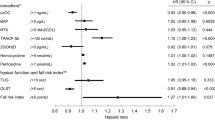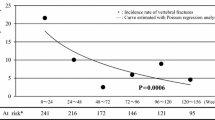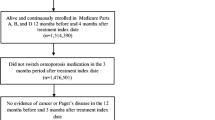Abstract:
Raloxifene reduces the risk of new vertebral fractures, but its effect on the severity of these new fractures has not been determined. The MORE (Multiple Outcomes of Raloxifene Evaluation) trial studied the effects of placebo, raloxifene 60 or 120 mg/day in 7705 postmenopausal women with osteoporosis. Radiologists assessed new vertebral fractures from radiographs and graded the fracture severity as normal (no fracture) or mild, moderate or severe. New clinical vertebral fractures were defined as new vertebral fractures associated with symptoms, such as back pain, and confirmed in radiographs. In the total study population, the majority (76.4%) of the women who experienced clinical vertebral fractures were diagnosed with new moderate/severe vertebral fractures. In turn, women with moderate/severe vertebral fractures in the overall population were more likely to experience clinical symptoms suggestive of fracture than were women who had new mild-only vertebral fractures. The incidence of new mild-only and moderate/severe fractures was the same in women without prevalent vertebral fractures, but the incidence of new moderate/severe fractures was 2 to 3 times higher than that for new mild-only fractures in women with prevalent vertebral fractures. Raloxifene 60 mg/day decreased the risk of at least 1 new moderate/severe vertebral fracture by 61% in women without prevalent vertebral fractures [RR 0.39 (95% CI 0.17, 0.69)], and by 37% in women with prevalent vertebral fractures [RR 0.63 (95% CI 0.49, 0.83)] at 3 years. The risk reductions for at least 1 new moderate/severe vertebral fracture were not significantly different between the raloxifene doses, in women with and without prevalent vertebral fractures. The effects of raloxifene on significantly decreasing the risk of new moderate/severe vertebral fractures may explain the risk reduction for new painful clinical vertebral fractures observed with raloxifene, and is particularly important in postmenopausal women with severe osteoporosis who are at higher risk for moderate or severe fractures.
Similar content being viewed by others
Author information
Authors and Affiliations
Additional information
Received: 11 April 2002 / Accepted: 19 June 2002
Correspondence and offprint requests to: Ethel Siris, MD, Toni Stabile Osteoporosis Center, Department of Medicine, College of Physicians and Surgeons, Columbia University, 180 Fort Washington Ave, New York, NY 10032, USA. Tel: +1 (212) 305 2529. Fax: +1 (212) 305 6482. e-mail: es27@columbia.edu
Rights and permissions
About this article
Cite this article
Siris, E., Adachi, J., Lu, Y. et al. Effects of Raloxifene on Fracture Severity in Postmenopausal Women with Osteoporosis: Results from the MORE Study . Osteoporos Int 13, 907–913 (2002). https://doi.org/10.1007/s001980200125
Issue Date:
DOI: https://doi.org/10.1007/s001980200125




